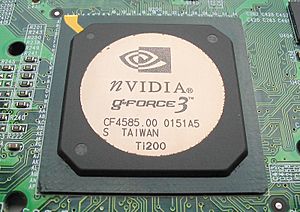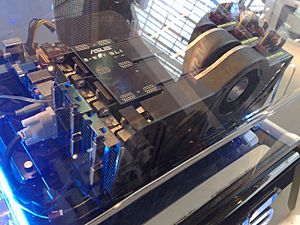Graphics processing unit facts for kids
A graphics processing unit (GPU) is like a special brain inside your computer. It's super good at making pictures, animations, and videos appear on your screen. A powerful GPU helps games and movies look smooth and amazing!
Contents
What GPUs Do: 2D and 3D Graphics
GPUs are built to create different kinds of images. These are called 2D and 3D pictures.
2D Pictures
Most computer programs, like your computer's desktop or writing apps, use two-dimensional (2D) pictures. These are flat images. Modern GPUs are so fast that even a basic GPU can handle 2D pictures perfectly.
3D Pictures
Some programs use 3D pictures to make things look real and deep, like they have height, width, and depth. Video games and design programs (like those for building cars or houses) use 3D graphics. The faster a GPU is, the better it can create these complex 3D worlds. More expensive GPUs are usually much better at 3D than cheaper ones.
Who Makes GPUs?
The main companies that design GPUs are Nvidia, AMD, and Intel. Many other companies, like Asus, MSI, and EVGA, then build the actual graphics cards using these designs.
Sometimes, AMD and Intel put a small GPU right inside the computer's main processor (the CPU). These are called "integrated GPUs." They are good for everyday tasks but not as powerful as a "dedicated" GPU. A dedicated GPU is a separate, more powerful card that plugs into your computer.
The History of GPUs
The first graphics cards appeared in the 1970s. They were used in arcade games to save money compared to using lots of RAM (computer memory).
In the 1980s, a new chip called LSI (Large Scale Integration) made it possible to put graphics cards into home computers. By the mid-1990s, graphics cards that could handle 3D graphics became common in arcade games, computers, and game consoles. The first GPU made for home computers was the Nvidia GeForce 256, released in 1999.
Modern Uses of GPUs
Today, GPUs are used in many devices.
- Computers and Game Consoles: They are essential for playing modern video games, which often need a powerful GPU to run smoothly.
- Virtual Reality: Devices like virtual reality headsets use GPUs to create immersive virtual worlds.
- Driverless Cars: These cars use GPUs to process information from cameras and sensors, helping them "see" and understand their surroundings.
- Other Tasks: GPUs can also help with things like editing photos and videos, and even with artificial intelligence (AI) tasks.
GPU Computing
GPU computing means using a GPU for more than just making pictures. It's like using the GPU's super-fast calculation power for other complex jobs. This is also known as "General Purpose Computation on Graphics Processing Unit" (GPGPU).
GPUs can help with:
- Calculating how things move in games (physics).
- Making AI programs work faster.
- Speeding up video and picture editing software.
One of the first programs to use GPU computing was Adobe Photoshop CS4.
Nvidia's CUDA
Nvidia has its own way of doing GPU computing called CUDA. It's a special tool that lets programmers use Nvidia GPUs for general tasks. CUDA is based on the C programming language.
AMD's Stream
AMD's system for GPU computing is called Stream. They had some earlier versions before Stream was officially released in 2008.
Powerful GPU Computers
In 2009, AMD announced a supercomputer that would be built using over a thousand GPUs! This computer was designed to be incredibly powerful, able to do one petaflop of calculations. That's a huge number of calculations per second!
External GPUs
An external GPU is a graphics processor that sits outside your computer. These are often used with laptop computers. Laptops usually have less powerful built-in graphics. If you want to play demanding games or do heavy design work on a laptop, you can connect an external GPU to get much better performance.
GPU Accelerated Video Decoding
Most GPUs made since 1995 can help your computer play videos more smoothly. They have special parts that handle video decoding. This means the GPU takes over the hard work of playing high-definition videos, so your computer's main processor (CPU) doesn't have to do it all. This makes videos play without stuttering and frees up your CPU for other tasks.
How GPUs Connect: Interfaces
Early GPUs connected to the computer's main board (motherboard) using a slot called PCI. This type of slot is still used today for simpler add-on cards.
As graphics cards became more powerful, a faster connection was needed.
- First came AGP.
- Then came PCIe x16, which is the standard connection used today.
- In 2008, PCIe 2.0 was introduced, which was twice as fast as PCIe 1.0 but still worked with older slots.
It's important to know that PCI cards only work in PCI slots, and AGP cards only work in AGP slots. PCIe cards need PCIe slots. However, newer PCIe 2.0 cards will work in older PCIe 1.0 slots, and vice-versa.
Multi-GPU Systems
Multi-GPU systems are computers that use more than one GPU. This is usually done in high-end gaming computers to make games run even faster. Sometimes, one GPU can handle the game's graphics while another GPU calculates realistic physics (like how explosions or water move).
History of Multi-GPU Systems
The first company to try using multiple GPUs was 3Dfx. Their Voodoo graphics cards could be linked together to get more performance. This was called SLi. While it didn't quite double the speed, it did make games run faster. Later, 3Dfx even tried putting multiple GPUs on a single card, like their Voodoo 6, which had four GPUs.
Nvidia's SLi
After Nvidia bought 3Dfx, they brought back the idea of multi-GPU systems in 2004, using the name SLi again. Today, SLi can link up to three graphics cards, which is called "3-way-SLi."
To build an SLi system, you need a special motherboard that has multiple PCIe slots for the graphics cards. Nvidia also makes "Dual-GPU" cards, which have two GPUs built onto one single card. These don't need a special SLi motherboard.
AMD's CrossFireX
AMD's multi-GPU technology is called CrossFireX. It works in a similar way to SLi. In 2007, it was renamed CrossFireX because it could combine more than two cards. Today, you can have a CrossFireX system with up to four graphics cards or two Dual-GPU cards.
Like SLi, you need a special CrossFireX-compatible motherboard to build this kind of system. However, if you use just one Dual-GPU card from AMD, you don't need a special motherboard.
Images for kids
See also
 In Spanish: Unidad de procesamiento gráfico para niños
In Spanish: Unidad de procesamiento gráfico para niños












